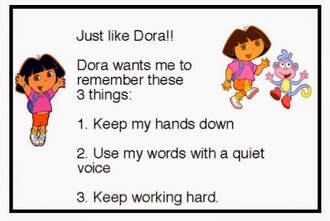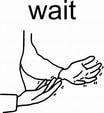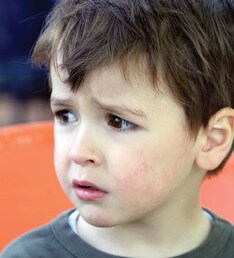#PowerCard
CARDS/POSTERS –
Power Cards are another VISUAL way by which to introduce change, new ideas, and/or desirable behaviors.
For instance, how would you introduce the concept that it’s okay NOT going to #school. You might create a ‘new understanding and #feelings’ about the need to stay home from school by first establishing what possible ‘old understandings and feelings’.
First know that ‘old understandings’ and ‘feelings’ someone has for staying home from school might be–
- Sick (felt badly)
- In trouble (felt upset)
- Severe weather (mixed feelings)
- Holiday or vacation (felt happy)
- Playing ‘hooky’ (felt guilty)
- Babysit siblings (mixed feelings)
All of these ‘staying home from school’ reasons and attached feelings which were somewhat temporary, because they each had a predictable ending. But, this new situation is ‘unpredictable’ and ‘undefinable’. Even #Shelter in Place and/or #Lockdown, or #Quarantine at school is understood by your child to have a beginning and ending.
Yau (2012) advises us that our child is likely to be much more of a visual thinker than you are. That spoken words are transitory – they are gone as soon as they are spoken. But visual tools are concrete, whether it be a real object, a photo, a symbol or a written word. Visuals can be returned to over and over again, helping your child understand, and sometimes to accept, the information. #VisualTools
< My Thought > “Visuals can be returned to over and over again…”
Types of VISUALS are – Visual Schedules, 5 point scales, Power Cards, Social Stories, & Comic Strips or Storyboards.
Yau commiserates that we all have good and bad days – days when the sun seems to shine on us, and days when the whole world seems to be against us. And it doesn’t need to be some huge thing to make us feel bad, sometimes the cumulative effects of everyday hassles can be just as stressful as a single big trigger.
He says that changes are inevitable, but often they can cause upset. If you know your child had difficulties with change, try to bring changes in gradually and with plenty of prior warning. Once a child is very upset, it can be very difficult to calm them down. It is best to distract or divert them before they get to the point of being upset.
Other professionals suggest talking the change through with your child by having a motivating reward available for your child once they accept the change. This lets them associate the change with something positive. Keep it concrete for the ‘literal’ thinkers.
Another way may be developing positive #mantras to use when things change, write it on a #PostIt and put it on the wall as a remainder, until they ‘get it’. Use wording that works for you and your child, like… “Things change, but its okay.”
Begin using a Visual Support by teaching a ‘Life Skill’ such as, ‘Asking for Help’, or ‘Learning How to Wait.’
#LifeSkill
Does your child know when and how to ask for help? Engineer situations where your child finds success when s/he asks for ‘help’ or is asked to ‘wait’. Approach this at a time when your child is in a good state of mind, and you are in an environment which supports you.
(Dora has been asked to ‘Remember’ 3 things…)
- List – REASONs & NEED for process, task, or change
- State – PROCESS in understandable age-appropriate terms
- Steps – SIMPLY explained in directive statements using 3 - 5 steps
- Show – VISUAL using actual picture, graphic, or regalia (face mask) to SHOW each step
- Restate – REASONS & allow for ANSWERS to questions, and changes in steps
Example of how the above Power Card format might look for the task of asking for ‘HELP’ –
- List – REASONs & NEED Sometimes I need help –
- State – PROCESS When I don’t know how to do something… I should ask for ‘help’.
- Steps – a. Ask for ‘help’ b. Ask before I get upset c. Make sure I am safe while I’m waiting for help
- Show – VISUAL Use pictures
- Restate – REASONS Now I know what to do when I need help
Make sets of cards to ‘transition’, if necessary, taking the child from ‘simple’ to ‘complex’ Actions/Behaviors. Other ways to approach stages of desired ‘change’ –
You might say that they are called POWER CARDS because they give you the ‘power’ to change. And, the ‘power’ to learn new skills which will help you have more choices every day. Teaching the concept of how to ‘wait’ is a ‘life’ skill that your child could learn, and the earlier the better. Otherwise s/he is going to be upset a lot…and you are going to be dealing with those upsets a lot.
“I want it and I want it now!” is usually what we hear from all children and some adults, at one time or another. Learning how to ‘wait’ is a huge skill… at home, in school, or a public place. Start with saying something positive, such as – “the swing is waiting for you while you eat your sandwich.” My son is non-verbal, but there is nothing wrong with his hearing…but, I find that Sonny responds to a visual clue like signing a ‘w’ just as easily as saying the word ‘wait.’
Another ‘level’ of POWER CARDS designed to do the following –
- Action or Desired #Behavior (List Steps)
- Use pictures (Personalize with favorite characters)
- Positive/reward/Consequences (Now I know what to do!)
- Next Step / Plan (For tomorrow or next session)
- Review & Role Play (Revise if necessary)
1. Action
Learning to ‘wait’ for something or someone
2. Use pictures
Showing ‘w’ wait sign
3. Positive/reward
I will go to the playground later this afternoon
4. Next Step / Plan
What to do while I’m waiting
5. Review & Role Play
Repeat what the Power Cards say
#RolePlay
Eventually, your child will begin to accept that ‘wait’ means that they will get what they want, but NOT just yet. Start introducing the concept with something your child likes and wants, but is NOT absolutely desperate for.
Lord (2004) shares a story about how the family motivates their autistic child with the mantra – Follow the Rules – Sister says, “Come on, David.” I let go of his sleeve, afraid I’ll rip it. When he was little, I could pull my brother behind me if he didn’t want to do something, but now David’s eight and too strong to be pulled.
Opening the front door, I sigh. My first day of summer vacation is nothing like I dreamed. I had imagined today warm, with seagulls winging across a blue sky, not overcast and damp.
“Let’s go to the video store,” David says, not moving one inch. “You’re going to the clinic. But if you do a good job, Dad’ll take you to the video store when he comes home.” The #video store is David’s favorite place.
Beside me, David checks his watch. “I’ll pick you up at five o’clock.” “Dad will pick me up at 5 o’clock. That’s the rule.” David leaps down the steps. He might not understand some things, but David loves rules.
Why is using VISUALS successful?
- Helps teach routines, expectations, and behavioral standards in an alternative way
- Reinforces correct behavior
- Shows more ways to be disciplined at an earlier age
- Uses a visual format (Link with favorite characters, animals, or Superheros.)
- Provides visual examples of #behavior expectations
- Delivers a more personalized and tailored behavioral intervention
- Involves children in the #learning process
- Gives child immediate feedback
- Works well with kids on the #autism spectrum and those with #ADD #ADHD
- Use when a child has difficulty remembering routines, clarifying behavioral expectations, understanding (new) concepts, or accepting change.
- Use when a child struggles to make a choice or has difficulty understanding a cause-and-effect relationship, or has an immature perspective concept.
- Use to support the generalization of skills. Other ‘needs’ can be helped by the same steps used for ‘anxiety’.
- Use when a child seems to lack motivation – using the child’s area of interest or special character as part of the visual presentation.
- (Need) Feeling #ANXIOUS
- (Understanding) I know what to do
- (Steps)
b.) Count to 10
c.) Take 5 big breaths
d.) Ask for a break
4. (Visual) Point out Pictures for each step
5.(Restate) Show that you know what to do
In other words, you can use Power Cards to:
a.) Create a desired outcome/change
b.) Allow for hands-on-learning
c.) Reuse cards as needed
Power Cards can be one of the first attempts to create ‘change’ in a child’s behavior, concept, or perception. They can be homemade by parents and children. They are very effective, yet NOT intimidating because of their simplicity, novelty, and child-friendly approach. They can also be used as a way to segue into a more involved presentation, such as Social Stories.
#VisualSupport #SocialStories
NEXT: Visual Support – Social Stories





 RSS Feed
RSS Feed